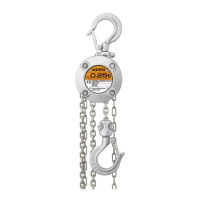25
Item Method Discard limit or criteria Action
Braking
mecha-
nism
Visually check the braking
surface to ensure no
abrasions or aws.
Do not lubricate the Friction
Plate.
The Friction Plate is a dry type brake.
Lubricating the Friction Plate may result in death
or severe injury due to insufficient braking.
• Should free of scars or gouged aws on the
braking surface of the Friction Disc, Friction
Plate, Ratchet Disc, and Hand Wheel
Assembly.
• The braking surface of the above mentioned
parts should not be excessively worn with
the tool marks erased and surface lustered.
Replace the scarred or
worn parts.
Check the crack of the
Friction Plate visually and
measure the abrasion using
calipers.
• The Friction Plate should be free of chips or
cracks.
Replace both Friction
Plates.
Measure the abrasion of
Bushing using a vernier
caliper.
• Should be uniform in thickness. Replace the Bushing.
Heat the Bushing with a
match ame to check that it is
impregnated with oil.
• Bushing should be sufciently impregnated
with oil (such that oil oozes off the surface
when heated).
Soak the Bushing in
turbine oil for a day and
wipe off excessive oil.
Two-ply
t
A
(Continued on the following page)
Rated load (t)
Thickness of two Friction Plates
Dimension t (mm)
Standard Limit
0.25 5.0 4.5
0.5
5.0 4.5
Rated load (t)
Dimension A (mm)
Standard Limit
0.25 1.4 1.2
0.5
2.0 1.8
For replacing or assembling Bushing, soak it in
turbine oil for a day, and wipe excessive oil from
its surface before reuse.
NOTE
Do not use any oil (grease, rust
preventive oil, etc.) in areas near
a fire or spark.
Failure to do so may result in ignition.

